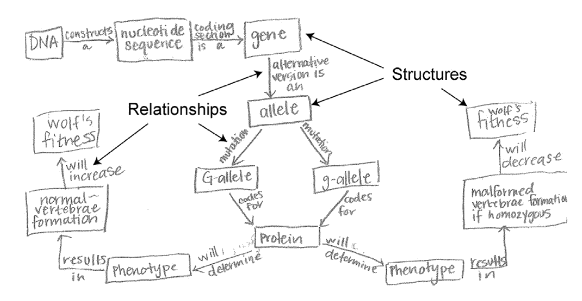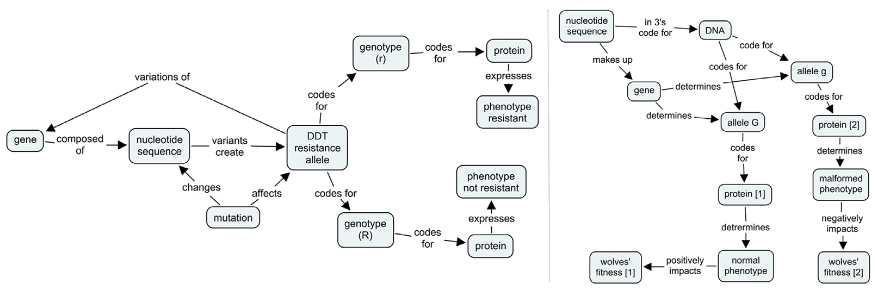|
|
|
|
|
|
|
News & Views item - July 2013 |
![]() Teaching Tertiary Students to Understand Biological Processes in the Context of
Systems. (July 26, 2013)
Teaching Tertiary Students to Understand Biological Processes in the Context of
Systems. (July 26, 2013)
As Science's Melissa McCartney puts it: "Reforms in biology education aim to develop students' understanding of biological processes in the context of systems, both within and across spatial and temporal scales."
Published in DOI10.1002/tea.21094 (J. Res. Sci. Teach. 10.1002/tea.21094 (2013))
the Journal of Research in Science Teaching the
full paper is available online![]() .
.

Figure 1.
Student GtE model. Student-constructed model showing structures in boxes,
relationships on arrows and overall representing the function of the model: show
origin of genetic variation and effects of genetic variation on phenotypic
variation and fitness of an organism.
Below we reprint the abstract.
Abstract: Research in contemporary biology has become
increasingly complex and organized around understanding biological processes in
the context of systems. To better reflect the ways of thinking required for
learning about systems, we developed and implemented a pedagogical approach
using box-and-arrow models (similar to concept maps) as a foundational tool for
instruction and assessment in an Introductory Biology course on genetics,
evolution, and ecology. Over the course of one semester, students iteratively
constructed, evaluated, and revised “Gene-to-Evolution” (GtE) models intended to
promote understanding about the connections linking molecular-level processes
with population-level outcomes. In practice, a successful GtE model
contextualizes information provided in a case study and explains how
genetic-level variation originates at the molecular level, is differentially
expressed among individuals, and is acted upon by the environment to produce
evolutionary change within a population. Our analyses revealed that students’
ability to construct biologically accurate models increased throughout the
semester. Model complexity peaked near mid-term then subsequently declined. This
suggests that, with time, students were building more parsimonious models,
shedding irrelevant information, and improving in their ability to apply
accurate and appropriate biological language to explain relationships among
concepts. Importantly, we observed the greatest relative gains in model
correctness among students who entered the course with lower mean GPA. In an
analysis comparing performance among achievement tritiles, lower-performing
students effectively closed the achievement gap with the highest performing
students by the end of the semester. Our findings support the effectiveness of
model-based pedagogies for science teaching and learning, and offer a
perspective on pedagogical application of modeling strategies to foster systems
thinking and knowledge structuring in college-level biology.
2013 Wiley Periodicals, Inc. J Res
Sci Teach 50: 639–659, 2013
Keywords: conceptual models; model-based pedagogy;
assessment; undergraduate education; evolution
